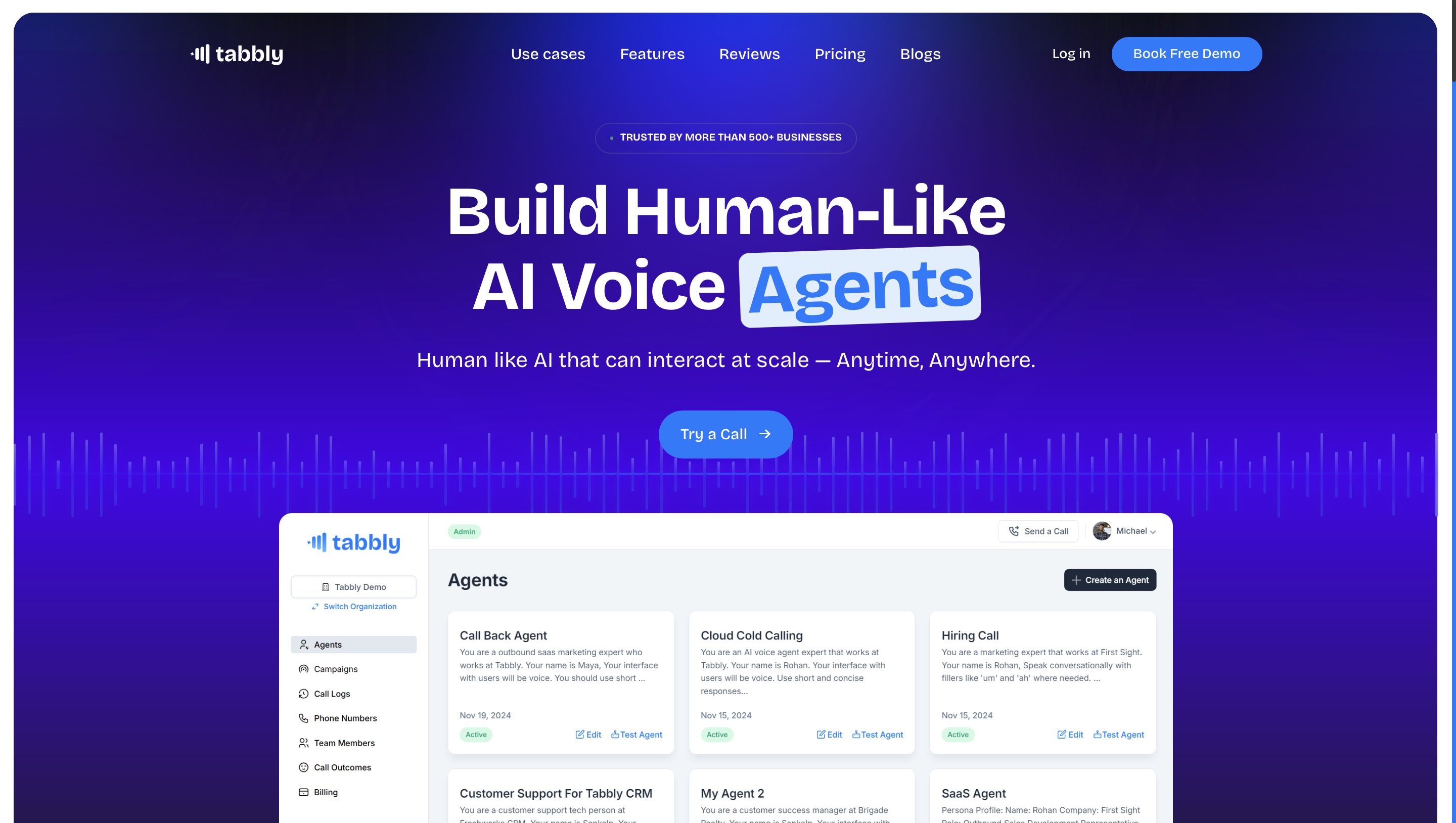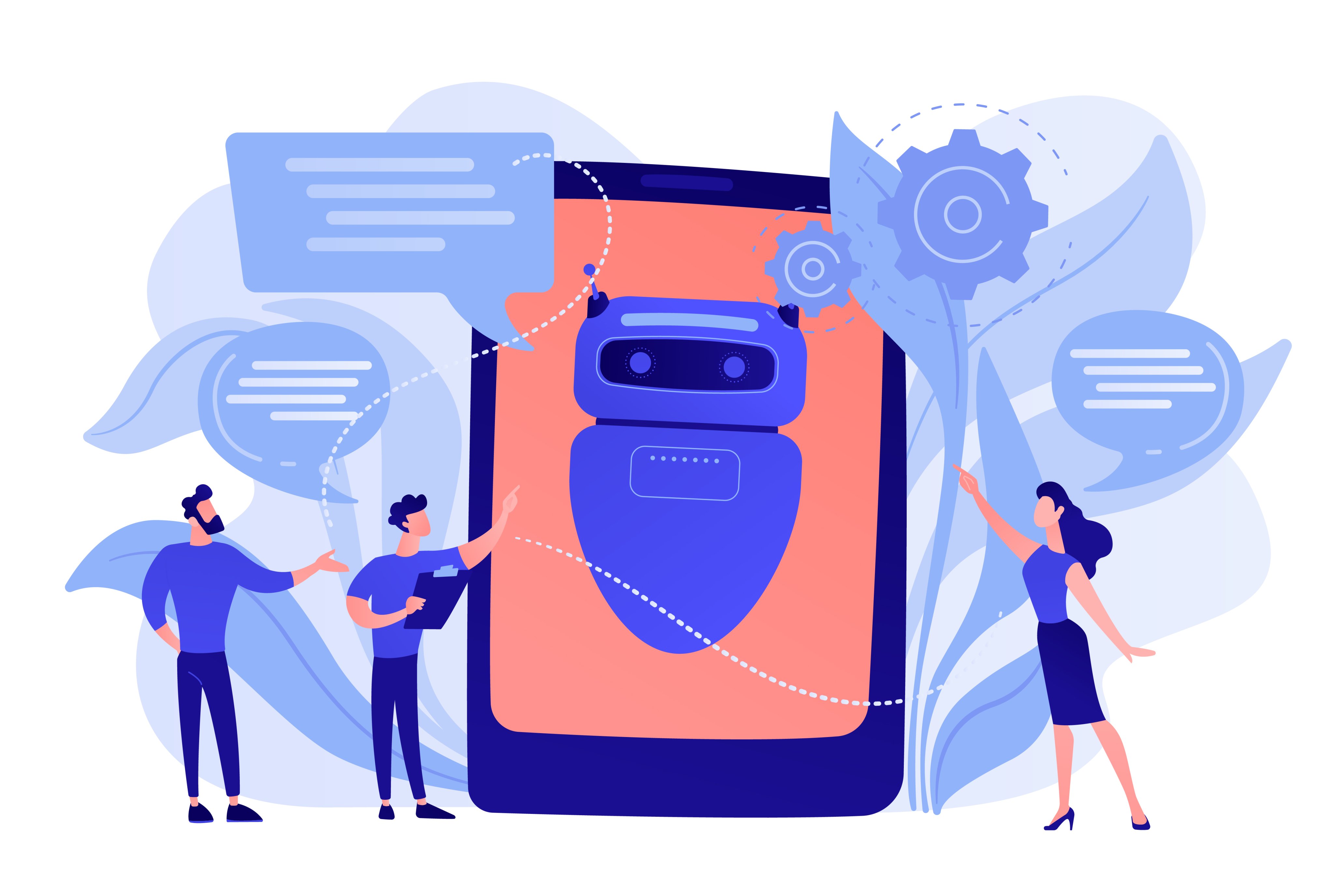The rise of AI voice agents marks a turning point in how we interact with technology. These agents, powered by conversational AI, are no longer just tools—they’re becoming companions in customer service, healthcare, and everyday life. But for them to truly shine, they need to sound human.
A realistic AI voice isn’t just about functionality; it’s about creating a human-like AI voice that builds trust, fosters engagement, and feels natural. Achieving this requires thoughtful AI voice training, focusing on everything from prompts to tone. In this guide, we’ll explore the best practices for AI voice agent development, offering actionable steps to optimize your agent for natural AI speech.
Whether you’re working on a platform like Tabbly.io or another system, these strategies will help you craft an agent that speaks with an authentic AI voice tone, bridging the gap between machine and human conversation.
The Importance of a human Like AI voice agent
Why prioritize a human-like AI voice? Because people connect with what feels familiar. A 2023 study by Gartner highlighted that by 2025, most customer interactions will involve AI, with satisfaction tied to how natural the agent sounds.
A robotic voice can frustrate users, while one trained with AI speech training techniques can make interactions seamless and enjoyable. This isn’t just about technology—it’s about conversational AI that mirrors human speech patterns, emotions, and adaptability. From answering queries to booking appointments, the goal of AI voice optimization is to create an experience that feels less like talking to a machine and more like chatting with a friend.
Let’s dive into the best practices to make this happen.
1. Start with a Robust Prompt for AI Voice Training
The cornerstone of AI voice agent development is the prompt—the instructions that shape its behavior and responses. A strong prompt is the first step in AI voice training, ensuring your agent delivers natural AI speech tailored to its purpose.
- Detail the Role and Goals: Specify what the agent does and aims to achieve. For instance, “You are a cheerful assistant for a travel agency, helping book trips and offering suggestions.” This clarity drives a realistic AI voice.
- Example: “You’re a support agent for TechTrend Innovations, answering SmartHub 3000 queries with a goal to resolve issues quickly.”
- Provide Context: Equip the agent with background info for relevant replies. This enhances AI voice optimization by grounding responses in real-world scenarios.
- Example: “You work for MediCare Plus, a clinic offering dental and general care—mention these services when booking appointments.”
- Infuse Personality: Add traits like warmth or wit to make the AI voice tone engaging. A playful agent might say, “Let’s snag that deal before it’s gone!” while a serious one opts for, “I’ll assist you promptly.”
On Tabbly.io, you’d input this during AI voice agent development, setting the stage for a human-like AI voice that users connect with. A well-designed prompt is like a script with flexibility—guiding yet adaptable.
2. Tailor Language to Your Audience
Humans adapt their speech to their listeners, and effective AI speech training ensures your agent does the same. Matching language to your audience is a key AI voice agent best practice for natural conversation.
- Use Industry Terms: Incorporate jargon users expect. A banking agent might say, “Your balance is updated,” while a healthcare one uses, “Let’s schedule your next visit.”
- Example: For e-commerce, “Your cart’s ready—want to checkout?” feels approachable and relevant.
- Consider Cultural Fit: With Tabbly’s multilingual options, adjust for cultural nuances. A French agent might say, “Voilà, c’est fait!” versus an English, “All set!” This boosts the realistic AI voice effect.
- Adjust for Demographics: A youthful tone might include, “Hey, no stress—got you covered!” while a formal one sticks to, “I’ll handle that for you, sir/madam.”
Testing this on Tabbly.io involves pairing the prompt with a voice that enhances the AI voice tone, ensuring it resonates with your target users naturally.
3. Build Conversational AI with Flow
Natural AI speech flows like a real dialogue, not a rigid script. Training your agent for conversational AI means teaching it to handle the organic nature of human talk.
- Support Multi-Step Tasks: Guide users through processes naturally. For a tech query, “Let’s start by checking your connection—what do you see?” keeps it smooth.
- Example: “Booking a hotel? Tell me your destination, then your dates.”
- Vary Responses: Avoid repetition for a realistic AI voice. Instead of “I don’t understand” every time, mix in, “Can you say that another way?” or “I missed that—try again?”
- Adapt to Shifts: Humans change topics—train the agent to pivot: “If the user switches focus, say, ‘Okay, let’s tackle that now!’”
AI voice optimization here involves testing on Tabbly.io, refining the prompt until the conversational AI feels fluid and human-like, not mechanical.
4. Embed Emotional Intelligence
A human-like AI voice isn’t just words—it’s emotion. AI speech training should include emotional intelligence to make interactions warm and relatable.
- Detect Emotions: Teach the agent to respond to cues like frustration with empathy: “I can tell this is tough—let’s fix it together.”
- Example: “You sound excited about this trip—I’m thrilled to help!”
- Reflect User Mood: Match enthusiasm (“Sweet, let’s get started!”) or stay calm for neutral queries (“Here’s the info you need”). This refines the AI voice tone.
- Soft Fallbacks: When unsure, avoid bluntness. “I’m a little lost—can you help me out?” feels human compared to “Error.”
Tabbly’s sentiment analysis can aid this, letting you tweak the prompt for a more emotionally aware, realistic AI voice during AI voice training.
5. Optimize with a Natural Voice
The voice itself is critical in AI voice agent best practices. Even perfect prompts falter if the delivery lacks natural AI speech.
- Pick Advanced TTS: Choose text-to-speech with lifelike intonation. Tabbly’s 50+ language options offer voices that sound human, not robotic—test them out.
- Example: A soothing voice for healthcare, “We’re here for you,” versus a lively one for retail, “Let’s grab that deal!”
- Align Voice to Role: A kids’ agent might be bubbly, while a legal one is steady and deep, enhancing the AI voice tone.
- Control Pace: Humans pause and emphasize—train the agent to slow for key points (“Here’s what matters…”) or pause after questions.
During AI voice optimization on Tabbly, select a voice that elevates your prompt into a human-like AI voice users trust.
6. Test and Refine for Realism
AI voice training isn’t a one-and-done process. Testing is a core AI voice agent best practice to ensure a realistic AI voice.
- Run Realistic Scenarios: On Tabbly.io, simulate calls—ask simple questions, vent frustration, or go off-script—to gauge performance.
- Example: “Where’s my package?” then “This is ridiculous!”—adjust if it feels stiff.
- Collect User Input: Ask, “Did I sound natural?” Feedback refines the AI voice tone and delivery.
- Keep Evolving: Update the prompt as needs change, using Tabbly’s analytics to spot weak spots.
This iterative AI voice agent development ensures your agent grows more human-like over time.
7. Design Graceful Fallbacks
Humans admit when they’re unsure, and a realistic AI voice should too. Fallbacks are essential for natural AI speech.
- Friendly Confusion: “I didn’t quite get that—can you rephrase?” beats a cold “Unknown input.”
- Example: “Oops, I’m stumped—tell me more?”
- Escalation Options: “This might need a human touch—should I connect you?” keeps it helpful.
- Positive Closures: “Thanks for chatting—I hope I was useful!” ends on a human note.
Add these to your Tabbly prompt for a conversational AI that stays approachable under pressure.
8. Personalise for Connection
Personalization makes a human-like AI voice feel intimate, a key goal in AI voice optimization.
- Leverage Data: Use names or history: “Hey Alex, back for more tech help?”
- Example: “Last time we sorted your order—how’s it now?”
- Flex to Preferences: Prompt it: “Short replies if they’re rushed, details if they’re curious.”
- Recall Interactions: “You asked about flights last week—ready to book?”
Tabbly’s JSON outputs can store this data, enhancing the AI voice tone with a personal touch.
9. Reflect Brand Identity
A realistic AI voice aligns with your brand, a subtle but vital AI voice agent best practice.
- Match Brand Style: A fun brand might say, “Let’s score that gadget!” while a premium one uses, “We’ll arrange it exquisitely.”
- Example: For a green brand, “Try our eco-friendly option!”
- Unified Voice: Keep it consistent with other channels—formal online, formal in calls.
- Embed Values: Prompt it to reflect ethos: “Highlight our community focus.”
Test this on Tabbly to ensure the AI voice tone fits your identity perfectly.
10. Use Analytics for AI Voice Optimization
Advanced tools elevate AI speech training, making your agent more human-like.
- Sentiment Tracking: Tabbly’s analysis adjusts responses—calm for anger, upbeat for joy.
- Example: “I hear you’re upset—let’s resolve this.”
- Review Transcripts: Spot unnatural phrasing in logs and refine the prompt.
- Go Multilingual: Train in multiple languages on Tabbly for a global, realistic AI voice.
These insights refine conversational AI into a dynamic, evolving partner.
Example of AI Voice Agent in Action
Let’s bring all these best practices to life with a tangible scenario: imagine you’re building an e-commerce AI voice agent on Tabbly.io for a fictional online retailer called ShopNow. This agent’s job is to assist customers with orders, promote deals, and create a delightful shopping experience. By applying the strategies we’ve discussed—ranging from crafting a detailed prompt to leveraging personalization and analytics—we can create a human-like AI voice that users will love. Here’s how it unfolds, step by step, with extra layers of insight to show the process in action.
- Prompt: “You’re a lively assistant for ShopNow, a trendy online store selling fashion and gadgets. Your role is to help with order tracking, answer product questions, and pitch daily deals in a fun, upbeat tone. Use phrases like, ‘Let’s snag that bargain!’ or ‘You’re gonna love this find!’ to keep it exciting. If the user’s unclear, say, ‘Whoops, can you say that again—I want to get this right for you?’ Offer to escalate complex issues with, ‘This one’s tricky—want me to grab a human helper?’”
- Why It Works: This prompt nails specificity—defining the role (assistant), tone (fun), and goals (assist and upsell). It adds personality with playful phrases and includes fallbacks for confusion, ensuring the agent stays engaging and helpful even when stumped.
- Voice: Select an energetic, female voice from Tabbly’s extensive library of over 50 languages. Picture a tone that’s bright and animated, with natural inflections that rise when pitching a deal (“This jacket’s a steal!”) and soften for empathy (“Oh no, let’s fix that!”). Adjust the pace slightly faster for excitement but with deliberate pauses after questions to mimic human rhythm.
- Added Detail: During selection, preview multiple voices—maybe a youthful one with a slight giggle versus a confident one with a warm undertone. Test how each pairs with the prompt to find the perfect match for ShopNow’s trendy vibe.
- Test: Simulate a call with, “Hey, where’s my order?” If the response feels flat (“It’s on the way”), tweak the prompt to, “Awesome, let’s track that package—gimme your order number!” Follow up with trickier inputs like, “It’s late, and I’m annoyed!” to ensure the agent shifts to, “I’m so sorry it’s delayed—let’s sort this out fast.” Record these tests on Tabbly to analyze tone and flow.
- New Point: Test edge cases too—like a user asking, “Can you sing me a song?” The agent might reply, “Ha, I’m no pop star, but I can help with your shopping—what’s up?” This keeps it human-like and redirects gracefully.
- Fallback: Beyond “I’m confused—help me out?” add variety: “Oops, I’m drawing a blank—can you give me a nudge?” or “Yikes, I’m lost in the shopping cart—say it again?” These keep the conversational AI light and approachable, avoiding the robotic “Error” trap.
- Added Nuance: Train it to recognize repeated failures (e.g., three unclear inputs) and shift to, “I’m not nailing this today—let’s get you to a pro, okay?” This mirrors how humans admit limits and seek help.
- Personalize: Leverage user data with, “Hi Mia, your last buy—that red hoodie—was awesome! Need more cool finds?” If Mia’s rushed, keep it short: “Mia, quick order update—on its way!” If she’s chatty, expand: “Mia, that hoodie’s a hit—how about some matching sneakers?” Prompt it to adapt: “Adjust based on user pace—short for hurry, detailed for leisure.”
- New Point: Use Tabbly’s JSON outputs to store preferences—like Mia’s love for red items—so future calls might start, “Hey Mia, got a red scarf deal just for you!” This memory mimics human rapport.
- Emotional Response: If Mia says, “I’m so excited for this sale!” the agent matches it: “Yes, Mia, this sale’s epic—let’s grab your faves!” If she’s upset (“My order’s wrong!”), it shifts: “Oh no, that’s not cool—I’m here to fix it, promise.” This emotional intelligence, refined via Tabbly’s sentiment analysis, keeps the AI voice tone spot-on.
- Added Layer: Prompt it to soften pitch for bad news: “Sadly, that item’s out of stock—but I’ve got a killer alternative!”
- Brand Alignment: ShopNow’s trendy, youthful vibe shines through with slang like “dope deal” or “total steal.” Prompt it: “Reflect ShopNow’s fun energy—keep it fresh and casual.” Test to ensure it doesn’t veer too formal (“Your purchase is confirmed”)—stick to, “You’re locked in—nice one!”
- New Point: Add a signature sign-off: “Catch ya later, ShopNow style!” This reinforces brand identity consistently.
- Analytics Check: Post-launch, use Tabbly’s call transcripts to spot hiccups. If users hang up after “Whoops, say that again,” tweak to, “No sweat, let’s try that one more time!” Sentiment data might show frustration at slow responses—speed up the voice slightly.
- Added Insight: Compare metrics—did personalized calls (e.g., “Hi Mia”) boost engagement? If yes, double down on data integration.
This example blends all the AI voice agent best practices into a cohesive, human-like experience. On Tabbly.io, you’d create this agent in minutes—input the prompt, pick the voice, test it live, and deploy. The result? A ShopNow assistant that’s not just functional but a joy to chat with—users might even forget it’s AI. Mia walks away smiling, order tracked, deal snagged, and loyalty secured—all thanks to a voice that feels like a friend.
Exploring the Tabbly.io AI Voice Agent
Tabbly.io emerges as a standout platform for AI voice agent development, offering a powerful yet accessible way to create agents that deliver a human-like AI voice. Found at tabbly.io, this tool simplifies AI voice training by letting users design custom agents without needing advanced coding skills, thanks to its intuitive design.
Start by crafting a detailed prompt to shape the agent’s role and AI voice tone, then choose from a library boasting over 50 languages for natural AI speech that suits diverse audiences. Tabbly’s AI voice optimization shines with features like JSON outputs, enabling structured data capture for personalized, conversational AI experiences, and analytics tools—think sentiment analysis and call transcripts—to fine-tune performance. At just $0.05 per minute, it’s a cost-effective solution for industries like customer service or healthcare, making Tabbly.io a go-to for building realistic AI voice agents that feel authentic and engaging.
Learn more about: Types of Prompts for AI Voice Agents
Conclusion: Mastering the Human Voice in AI
Training an AI voice agent to sound human is a blend of AI voice training, conversational AI design, and relentless optimization. From crafting prompts to leveraging Tabbly.io’s tools, these AI voice agent best practices create a realistic AI voice that connects deeply. Whether it’s natural AI speech for customer service or an AI voice tone for healthcare, the result is an agent that feels alive. Start your AI voice agent development today—apply these strategies, and transform how your audience hears your brand.
1. How does AI voice training contribute to a human-like AI voice?
Answer: AI voice training is the process of teaching an agent to mimic human speech patterns, a key step toward achieving a human-like AI voice. By crafting detailed prompts—e.g., “Speak warmly and pause naturally”—and refining them with sample interactions, you shape the agent’s delivery. Platforms like Tabbly.io enhance this by offering voice options and analytics, ensuring the agent sounds authentic and relatable, not robotic.
2. What are the top AI voice agent best practices for natural AI speech?
Answer: AI voice agent best practices for natural AI speech include defining a clear role and tone in the prompt, using conversational language, and testing responses for flow. For instance, vary replies like “Can you repeat that?” with “Oops, missed it—say again?” to avoid stiffness. Regular tweaks based on user feedback ensure the agent’s speech feels organic and engaging.
3. How can AI voice optimization improve conversational AI?
Answer: AI voice optimization enhances conversational AI by fine-tuning elements like pacing, intonation, and response relevance. Tools like Tabbly.io’s sentiment analysis let you adjust the AI voice tone—e.g., softening it for upset users—while multilingual voice options broaden its reach. This creates a seamless, human-like dialogue that keeps users immersed in the conversation.
4. Why is AI speech training essential for a realistic AI voice?
Answer: AI speech training is crucial for a realistic AI voice because it teaches the agent to adapt to real-world inputs, like emotional cues or off-topic questions. By testing prompts—e.g., “Respond cheerfully to excitement”—and iterating with call data, you refine its delivery. This training ensures the agent sounds natural and lifelike, not scripted or mechanical.
5. What role does AI voice agent development play in achieving an effective AI voice tone?
Answer: AI voice agent development shapes the AI voice tone by blending design and refinement. During development on platforms like Tabbly.io, you set the tone—e.g., “professional yet friendly”—via prompts, pair it with a fitting voice, and use analytics to polish it. This process crafts a tone that aligns with your goals, making the agent both effective and human-like.









